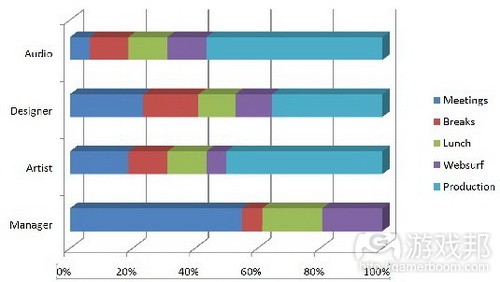改善员工爆发性效率和工作习惯的重要性
作者:Alexander Brandon
什么是高效的工作?
在此经济形势下,很多人都会留心自己的消费方式,积极探索更多省钱的渠道。我们都知道,游戏行业及整个经济体系面临的一个主要问题是,“你是雇佣全职人员,还是合约制人员?”
采用全职形式,雇员会得到更大保障,但雇主承担更多风险。而合约/兼职形式对雇主来说风险更小,但雇员将缺乏保障。若想要寻找的是经验丰富的人士,那么合约模式多半不是他们的首选。
但这远没有这么简单,还涉及某些更根本的元素。
工作爆发性
你有多少员工每天固定工作8小时?
这包括会议。我想你会发现,在创意行业,大家很少每天固定工作8小时。行业并非采用这样的工作模式。你会发现,大家的工作更多是爆发性的。我当然也是如此。
无论是美工、设计师、音效设计师,或者甚至是工程师,这些爆发性的工作可以短到几小时,长至12-14多小时。我合作过的有些疯狂程序员,他们进行的爆发性工作有时甚至持续更长时间,在8-9小时的固定工作时间后,无论你觉得自己多么兴奋,你的效率都会开始下降。
控制时间
观察的最终结果是,我建议管理者充分利用雇员的时间。在Heatwave,我们的董事长Anthony Castoro设定一个20分钟的“休息时间”,旨在将1天划分成更多单元,让雇员的大脑能够获得更好的恢复,让爆发性工作创作出更多的成果。
但我们所能做远不止如此。各全职员工在不同任务中会表现出不同的效率。有时工作进度也许过于缓慢,所以同员工协商工作进度是个明智选择。他们是否想要成立专案小组,尝试新的构思?同他们之前从未讲过话的团队成员合作如何?报班学习他们缺少的技能?
观察
对管理者来说,留住员工和保持收益水平/操作方式/技术/产品一样重要。大型公司多半会存在很多不知道自己想要做什么及如何进行自我激励的年轻员工。
管理者不要只是将任务分配给他们,然后转身走开,而是应该在分配完工作后观察他们的工作习惯。管理者不妨在不引起他们注意的情况下隔几天就走过他们的桌旁,窥探他们在做什么。若你发现他们原本可以更快完成工作,只是由于他们腾时间上网,你不应威胁称要限制他们的网络访问权限,以及询问什么原因促使他们这么做。浏览网页是因为大脑觉得乏味,需要新的输入内容。他们需要靠练习摆脱此习惯,学会专注于需要完成的工作。
另一创造高效爆发性的方式是提供强制休息时间,同时给予员工超越其驾驭范围的任务,但不要过度紧逼他们。这里的理念是,查看员工能够将自己的技能扩展至何种程度。
我共事过的优秀员工是那些身陷困境后能够积极同众多人士沟通,以期顺利解决问题的人员。但他们最初也许并非这么做的。若员工积极求教,且保持良好仪态(游戏邦注:这能够有效帮助他们解决问题),他们很快就会变成解决问题的高手,获得提拔。
这些就是你阅读“工作方法”及“保持高效性”之类商业书籍的原因所在。我们常常会撰写有关这类话题的文章,但鲜少将此付诸实践的原因在于:这颇有难度。
但至少懂得如何提高爆发效率和观察团队成员的管理者能够很快学发现什么能够提高成员的积极性,因为不同人有不同的激励因素。他们的团队会因此变得更富效率,因为成绩显著的积极团队也会影响到团队管理者,而且能够创造灵感。
游戏邦注:原文发布于2009年11月13日,文章叙述以当时为背景。(本文为游戏邦/gamerboom.com编译,拒绝任何不保留版权的转载,如需转载请联系:游戏邦)
What Are The Game Industry’s Work Habits?
by Alexander Brandon
What is effective work?
In this economic climate a lot of people take stock of how they spend and examine more ways to save. I think we’re all aware of one of the main issues facing not only the game industry but the overall economy, being “do you hire full time or do you contract?”
Hiring full time supposedly gives more security to the employee but more risk for the employer. Contract / part time is less risk for the employer but less security for the employee, and if you’re on the hunt for someone with experience, chances are contract is not their preference.
But there’s of course more to it than that, something perhaps even more fundamental.
Work Spurts
How many of your coworkers put in a full 8 hour day of solid work?
This includes meetings. I think you’ll find that particularly in creative industries, people don’t work a steady 8 hours. It just doesn’t work like that. More often than not you’ll find that people work in spurts. I certainly do.
Whether speaking about the artist, the designer, the audio designer or even engineers, these spurts can last anywhere from a few hours to over 12-14 hours. Some insane programmers I’ve worked with can get on a kick that lasts even longer, and after 8-9 hours of steady work, regardless of how pumped you feel, your effectiveness begins to drop.
Take Control of Time
The result of this observation is my recommendation to managers and directors to utilize your employee’s time to your fullest advantage. At Heatwave our President, Anthony Castoro, has instituted a 20 minute “recess” as a way to break the day up more, providing a chance for the brain to reset and allow a bit more fertile soil for these spurts to grow.
But it can go even further. Each full time employee has their own degree of effectiveness based on certain tasks. At times the workload may be slower, so speaking to this employee about where their mind would like to turn is a good idea. Do they want to institute a skunkworks and try some new ideas? How about interacting with members of the team they’ve never talked to before? Taking a course to improve a skill they might need help with?
Observe
It is just as important for a manager to maintain their employees as it is for them to maintain their profit / process / tech / products. In a large company chances are there are a good many junior employees who have no idea what they want to do and have no clue about how to be self motivated.
Rather than task them and walk away, task them and observe their work habits. Stroll casually by their desk once every few days or so without drawing attention, and shoot a glance at exactly what they’re doing. If you discover that they could be doing their work faster because they’re doing too much web surfing, you’re not out of line to threaten to restrict their web access and also ask what it is that motivates them. Web surfing is the brain’s way of saying it is bored and needs input. It takes practice to get out of this habit and focus on tasks you need to complete.
Another way to generate effective spurts is to provide mandatory breaks like recess, and at the same time give the employee just a little more than you know they can handle. Don’t crunch them to death. The idea here is to see how much an employee can grow their skill set.
The best people I’ve worked with are confronted with difficult problems and talk to as many people as they can consistently to get that problem solved. But they may not have started out this way. When an employee is shown that asking questions and maintaining a calm professional demeanor while doing so is a great way to solve problems, they can grow very quickly as problem solvers and rise through the ranks.
All these concepts and many more are the reason you see business books about “how to get it done” and “be effective”. People write about this all the time but very seldom put it into action for one simple reason: it’s hard.
But at the very least managers armed with the knowledge of spurts as well as observation of their teams will quickly be able to discover what can really get people motivated, since everyone has different motivators. And with this, their team will become more effective, because a motivated team with consistent accomplishments reflects back on the manager and generates inspiration.(Source:gamasutra)









































 闽公网安备35020302001549号
闽公网安备35020302001549号